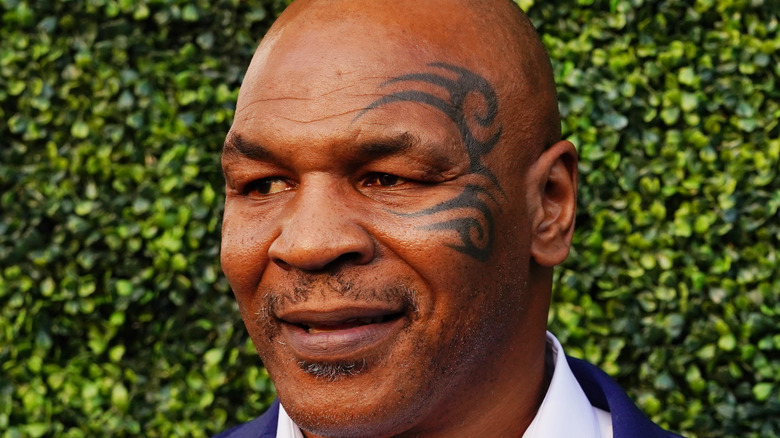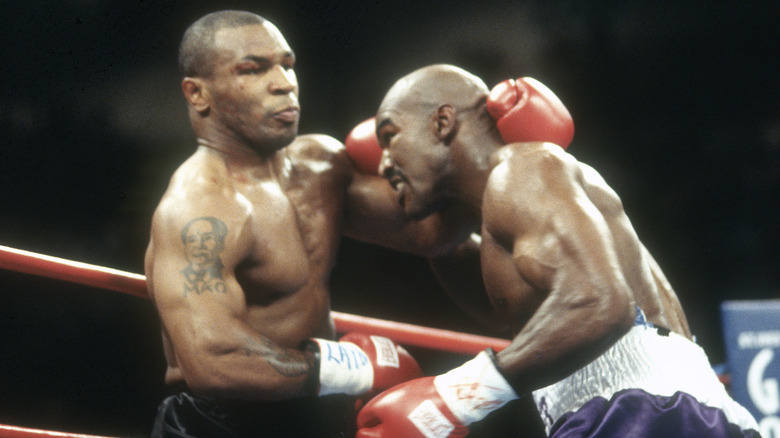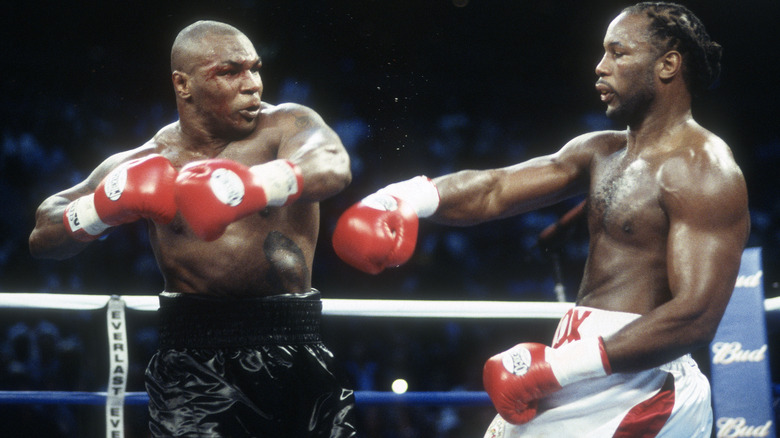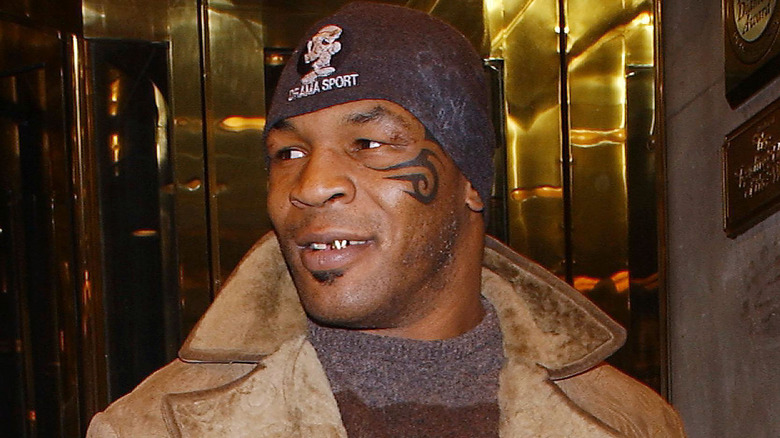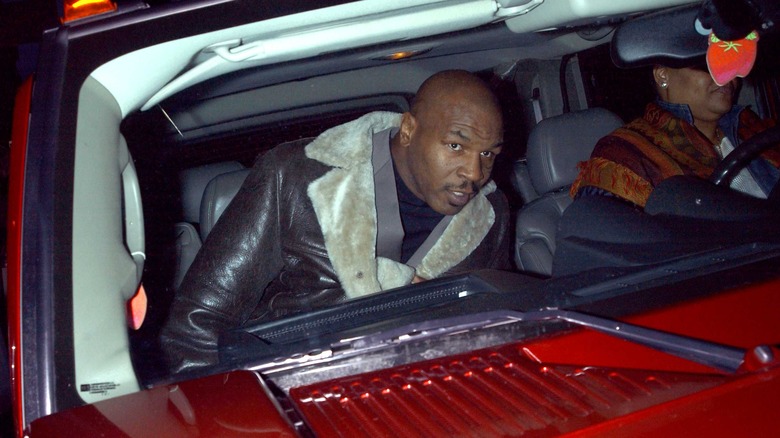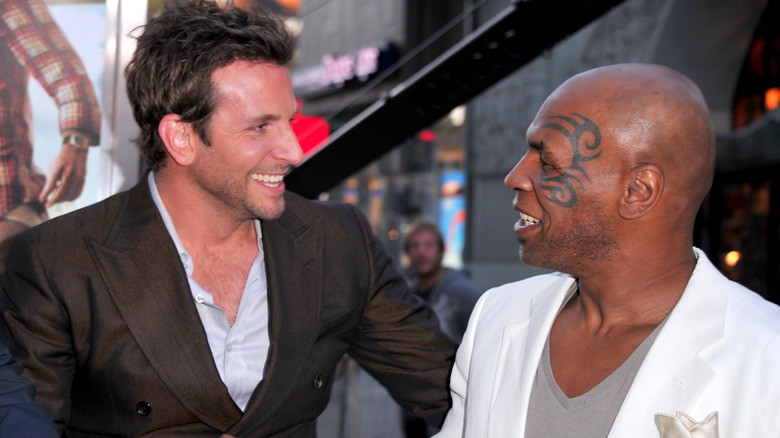Why Mike Tyson Filed For Bankruptcy
There are no two ways about it — Mike Tyson is an all-time great in the world of boxing, and he's deservedly up there with the likes of Muhammad Ali as one of the few professional pugilists to also become a pop culture icon away from the ring. His knockout power was almost matched by his charisma, and back when dropping fighters left and right was just another day at the office for the Baddest Man on the Planet, his name was a license to print money. Aside from all the dough he earned for his in-ring victories and championship defenses, he lent his name to properties such as the video game "Mike Tyson's Punch-Out!!," guested on TV shows like "Who's the Boss?" and "Roseanne," and starred in videos from Whitney Houston and DJ Jazzy Jeff & The Fresh Prince. That's right, Will Smith once thought he could beat Iron Mike.
Most of us know what came next for "Iron Mike" after a few years on top of boxing's heavyweight division — the rape case, the time in prison, the ear-biting incident, and how his boxing career ended with a whimper rather than a bang. Those weren't the only challenges Tyson faced, as in 2003, he filed for bankruptcy despite making hundreds of millions of dollars as the most famous boxer of his generation.
Tyson was besieged by legal trouble and controversy in the '90s
As the next big thing in boxing, Mike Tyson was as dominant as they came in the late '80s. When he lost his heavyweight championship to James "Buster" Douglas via TKO on February 11, 1990, in what was considered a tremendous upset (via Britannica), it only proved to be a momentary setback for Iron Mike, who won his next four bouts. Then came the Desiree Washington case, as Tyson was convicted in February 1992 of raping the beauty pageant contestant and sentenced to six years in prison; he was released in 1995 after serving three years of his sentence.
Now a free man once again, Tyson wasted little time in regaining two of the title belts he lost, but in 1996, he suffered his second career loss against Evander Holyfield, and this time, it wasn't a fluke. More controversy came in June 1997 during their rematch, as Tyson thought little of making a meal out of Holyfield's ear, getting him disqualified as he also lost his boxing license as punishment for his odd culinary choices; he was, however, reinstated in October 1998. But just when Tyson seemed to be off to a good start in his second comeback after knocking out Frans Botha in the fifth round of their January 1999 fight, he was back in the slammer that same year after pleading no-contest to charges of assaulting two men following a 1998 vehicular accident.
His in-ring career seriously declined during his second comeback
Although it seemed as if Mike Tyson was in the headlines for the wrong reasons more often than he was in the ring for most of the '90s, he did find some new ways to make money when he wasn't working — or couldn't work — at his day job. Wrestling fans will certainly remember his involvement in the lead-up to WrestleMania XIV in March 1998, where he served as a special guest enforcer for the WWE Championship match between reigning titleholder Shawn Michaels and "Stone Cold" Steve Austin. At the end of the day, however, Tyson was still a professional boxer.
When Tyson returned to the ring after serving only a few months of his one-year sentence for the aforementioned assault charges, it was more of the same — knock out a few relative tomato cans, get a marquee fight against another top name, lose to said top name, typically in embarrassing and/or controversial fashion. Tyson was utterly dominated by Lennox Lewis and knocked out in the eighth round of their June 2002 bout, and not helping matters was the string of troubling events in the lead-up to that fight. His October 2000 knockout win over Andrew Golota was changed to a no-contest when Tyson tested positive for marijuana, and his penchant for biting rivals reared its head during a press conference where he brawled with Lewis and later on chomped on his leg. That got him fined $335,000 (via Black Enterprise), and the eventual loss to Lewis was just a primer for what would happen one year later.
The bankruptcy: Tyson racked up $27 million in unpaid debt
By 2003, the chickens had come home to roost for Mike Tyson. Unable to sustain a comeback without some incident (and/or shameful high-profile loss) getting in the way, the millions Iron Mike had earned had almost vanished, and in August 2003, he filed for Chapter 11 bankruptcy at the United States Bankruptcy Court in Manhattan. Over a career that had, at that time, spanned close to two decades, Tyson had made approximately $400 million, but as it turned out, he was spending money just as fast as he earned it, something that may have been especially troublesome as his career went into decline and the marquee bouts dried up.
As reported by The New York Times, Tyson was in debt to the tune of more than $27 million when he filed for bankruptcy, and his list of creditors included the I.R.S. ($13.4 million), British tax officials ($4 million), seven law firms (cumulatively $600,000), former trainer Stacey McKinley ($800,000), and financial manager Barry Hankerson ($500,000). He also owed close to $52,000 in child support to Kimberley Scarborough, who had a daughter with Tyson in 1991. The boxer's assets were nothing to sneeze at, as they were valued between $10 million and $50 million, but when you're almost $30 million in debt, bankruptcy is sadly the best solution.
His spending habits left him with no other choice
As mentioned above, Mike Tyson was a profligate spender, and that played a large part in the "financial distress" he had been going through since 1998, according to an affidavit he filed along with his bankruptcy (via The New York Times). That was the time when he was allegedly "burdened with substantial debt to Showtime, taxing authorities and parties to litigation," though he also mentioned in the document that his fight income and the money he got from the sale of certain assets helped him pay off some of his debts. But he was still having great trouble "paying the bills," and many blamed it on his reckless spending habits.
”He spent enormous amounts of money that were inappropriate at best,” Sanford Ain, the divorce lawyer of Tyson's ex-wife Monica Turner, told the Times. ”Part of it can be attributed to a lack of willpower. Part of it can be attributed to people who he let get close to him and depended on his goodwill and took advantage of him.”
According to papers filed during Tyson's divorce from Turner, the boxing great was, at one point, spending $400,000 a month to pay for his lavish lifestyle. The documents also pointed to a period from 1995 to 1997 where Tyson paid a whopping $9 million in legal fees, threw a birthday party worth $410,000, and spent $230,000 on cellphones and pagers. As recently as 2002, he was running up unpaid bills for his luxuries, including $65,000 for limousine services and $8,100 for the care of his pet tigers.
It's been a long road back to apparent solvency for Iron Mike
Boxing history is littered with sad stories of once-proud fighters who fell on hard times after their careers ended. Thankfully for Mike Tyson, he seems to be doing very well for himself these days, though it was quite a long road back. Iron Mike had another two fights after his 2003 bankruptcy filing, but lost both of them; he literally quit in the middle of his final bout against unheralded Irishman Kevin McBride, and it was clear that he was far removed from the unstoppable knockout machine he was in his prime years. After the McBride fight, Tyson effectively announced his retirement (via BBC), saying that his heart was no longer in it and that he was "just fighting to pay off the bills."
After retiring from active competition, Tyson tried to pay the bills by launching an exhibition tour in 2006, but after a poorly-received fight against journeyman Corey Sanders, the rest of the tour was canceled (via CBS Sports). Fortunately, he found his way back to pop culture relevance a few years later, thanks to his appearances in the first two "Hangover" films in 2009 and 2011. And in 2020, he returned to the ring for another exhibition bout, that time fighting to a draw against fellow legend Roy Jones Jr.
In 2018, Tyson started a marijuana company originally known as Tyson Holistic but eventually renamed The Ranch Companies (via GQ). And he's still endorsing products and making celebrity guest appearances here and there; he's appeared multiple times on All Elite Wrestling and was on hand at the company's Double or Nothing pay-per-view in 2020 to present Cody Rhodes with the inaugural TNT Championship. All in all, life seems good for the Baddest Man on the Planet nearly two decades after he declared bankruptcy.
